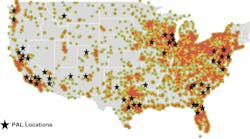New hours-of-service rules have a financial downside for fleets - and consumers
New government regulations tend to generate lots of publicity about the benefits that will ensue. But more often than not, the costs incurred in implementing them don't receive much press.
Let's take hours-of-service rules as a case in point. The proposal was published in the Federal Register April 25, but since the regulations have not been finalized, I'll have to make some assumptions about how they'll play out. It looks like time spent driving, loading and unloading, and waiting to load and unload will all count against allowable hours of service. Let's also assume that 60 hours in 7 days will be the maximum allowed.
A while back, we did a study for the Truckload Carriers Assn. (TCA) about the amount of time drivers of dry vans and refrigerated units spent waiting. We found that during the course of a week, dry-van drivers spent, on average, 33.5 hours waiting, while those in the refrigerated segment spent 42.8 hours waiting. We also found that dry-van operations hauledabout five loads a week and refrigerated operations four. Using the Census Bureau's "Vehicle in Use Survey," we estimated that slightly more than 380,000 drivers move dry van and refrigerated TL freight over 200 mi. one way.
We used the same methodology to estimate the impact of the new hours-of-service rules on trucking, given the assumptions mentioned above.
First, we determined the number of trips expected at various average speeds (depending on length of haul), allowing for two hours of time at the end of each trip. This covers loading and unloading time, but not all the time spent waiting. Next, we estimated how many more drivers and power units would be needed if time spent waiting to load and unload, as well as actual loading/unloading time, applies to hours of service.
Although we had only dry van and refrigerated trailers in our TCA analysis, we feel comfortable applying the data to an hours-of-service impact analysis because these two categories account for about 75% of trailers running a minimum of 200 mi. per haul.
Assuming a 200-mi.-minimum haul, the number of drivers and power units would have to increase by 47% to handle the same amount of freight under the new hours-of-service rules. Initial estimates put this at slightly more than 180,000. Since units running 200-mi.-minimum hauls are primarily interstate operations, we're comfortable using this to estimate the impact of new federal rules.
If we use operations running hauls of 100 mi. or more to estimate the impact of the rules, the number of drivers and corresponding power units would have to increase by 56% to handle a like amount of freight. Our initial estimate puts this at slightly more than 270,000. Although the 100-mi. range has more intrastate-only activity than the 200-mi. range, the majority will still operate interstate for at least a portion of their runs.
If new hours-of-service rules are strictly enforced, there will be pressure on carriers to hire more drivers and buy new equipment. But given the tight labor market, hiring more drivers is just not realistic. And being able to increase returns on investment enough to justify buying more equipment is equally unrealistic. Carriers will have no choice but to substantially increase their investment in inventories.
Over the past decade, our economy, with the help of the transportation sector, took nearly $130-billion out of the investment required for inventories. Putting that investment back in place will reduce the funds available to increase productivity and raise wages.
This increase in costs will inevitably be passed on to consumers. Maybe that should be part of the publicity campaign, too.


